Details

Visually Observing Comets
Astronomer's Pocket Field Guide
|
35,30 € |
|
| Verlag: | Springer |
| Format: | |
| Veröffentl.: | 15.03.2017 |
| ISBN/EAN: | 9783319454351 |
| Sprache: | englisch |
Dieses eBook enthält ein Wasserzeichen.
Beschreibungen
<p>In these days of computers and CCD cameras, visual comet observers can still contribute scientifically useful data with the help of this handy reference for use in the field. Comets are one of the principal areas for productive pro-amateur collaboration in astronomy, but finding comets requires a different approach than the observing of more predictable targets. Principally directed toward amateur astronomers who prefer visual observing or who are interested in discovering a new comet or visually monitoring the behavior of known comets, it includes all the advice needed to thrive as a comet observer.<br></p><p>After presenting a brief overview of the nature of comets and how we came to the modern understanding of comets, this book details the various types of observations that can usefully be carried out at the eyepiece of a telescope. Subjects range from how to search for new comets to visually estimating the brightness of comets and the length and orientation of tails, in addition to what to look for in comet heads and tails.<br></p><p> </p><p>Details are also given of 20 periodic comets, predicted to return between the years 2017 and 2027, that are expected to become suitable targets for visual observing, in addition to information on a famous comet potentially visible each year and subject to great outbursts of brightness. </p>
<p>Preface.- Part I – INTRODUCING COMETS.- Ch. 1 Comets Throughout History.- Ch.2 Comets in Motion.- Ch 3 Toward the Modern Understanding of Comets.- Ch. 4 The Formation of Tails.- Ch.5 The Origin of Comets.- Ch. 6 A Reservoir of Comets!.- Part II – THE ROLE OF VISUALCOMET OBSERVERS IN THE AGE OF CCDs.- Ch. 7 The Value of Visual Observing in a Photo-Happy World.- Ch.8 Visual Comet Hunting.- Ch.9 Observing Known Comets.- Ch.10 The Coma: How to Estimate its Brightness and Record Its Features.- Ch.11 Observing the Tail of Comets – What to Look For and Record.- Ch. 12 Recording and Reporting Your Observations - Part III – THE NUTS AND BOLTS OF COMET OBSERVING.- Ch.13 Relatively Bright Comets Predicted to Return From 2017 to 2027.- Ch.14 29P/Schwassmann-Wachmann: An "Outbursting" Comet to Watch.- Ch. 15. Some Prominent Visual Comet Discoverers - Ch. 16. The Kreutz Sungazing Group - A SpecialOpportunity for Visual Comet Hunters - Ch. 17. Numbered Observable Short-Period Comets - Ch. 18. Unnumbered Short-Period Comets - Appendix 1 Atmospheric Extinction Tables.- Appendix 2 The Phase Angle of a Comet - Appendix 3 "Lost" Short-Period Comets - Appendix 4 Lunar Phases 2017 to 2027 - Glossary of Terms.</p>
David Seargent is a former part-time lecturer in Philosophy with the Department of Community Programs at the University of Newcastle (Australia). He is a regular contributor of a comet column to <i>Australian Sky & Telescope</i> and formerly to <i>Sky & Space</i> magazine. Additionally, he authored the following books in Springer’s <i>Astronomers’ Universe </i>series: The Greatest Comets in History; Weird Astronomy; Weird Weather; Weird Worlds; Weird Universe; Weird Astronomical Theories of the Solar System and Beyond.
<p>In these days of computers and CCD cameras, visual comet observers can still contribute scientifically useful data with the help of this handy reference for use in the field. Comets are one of the principal areas for productive pro-amateur collaboration in astronomy, but finding comets requires a different approach than the observing of more predictable targets. Principally directed toward amateur astronomers who prefer visual observing or who are interested in discovering a new comet or visually monitoring the behavior of known comets, it includes all the advice needed to thrive as a comet observer.<br></p><p>After presenting a brief overview of the nature of comets and how we came to the modern understanding of comets, this book details the various types of observations that can usefully be carried out at the eyepiece of a telescope. Subjects range from how to search for new comets to visually estimating the brightness of comets and the length and orientation of tails, in addition to what to look for in comet heads and tails.<br></p><p></p><p>Details are also given of 20 periodic comets, predicted to return between the years 2017 and 2027, that are expected to become suitable targets for visual observing, in addition to information on a famous comet potentially visible each year and subject to great outbursts of brightness. </p>
Includes suggestions for observing periodic comets in addition to finding new comets Small trim size and to-the-point text make this ideal for use as an on-the-go-reference Explains the possibilities for an amateur observer to make a significant contribution to planetary science through comet-spotting Includes supplementary material: sn.pub/extras

















